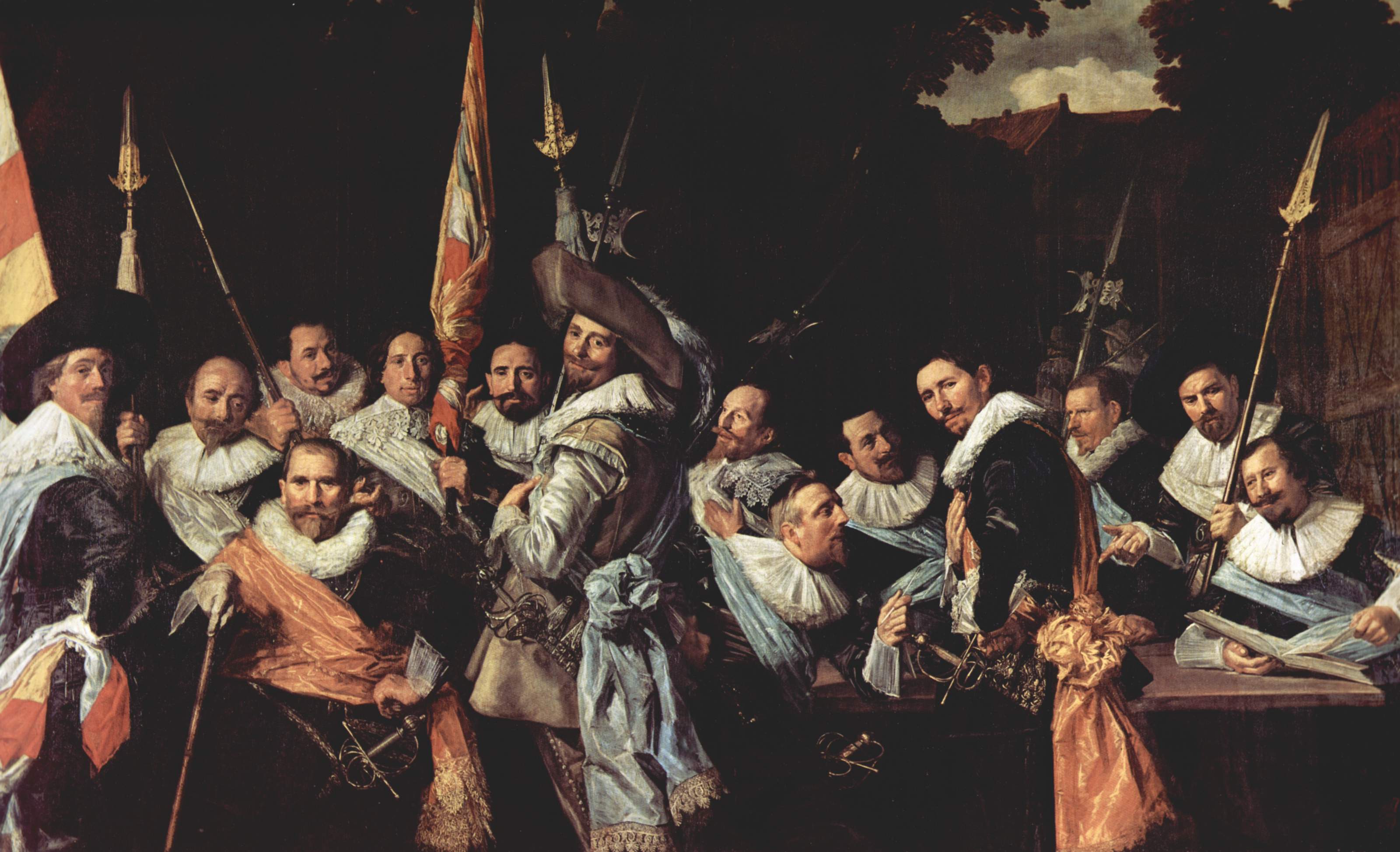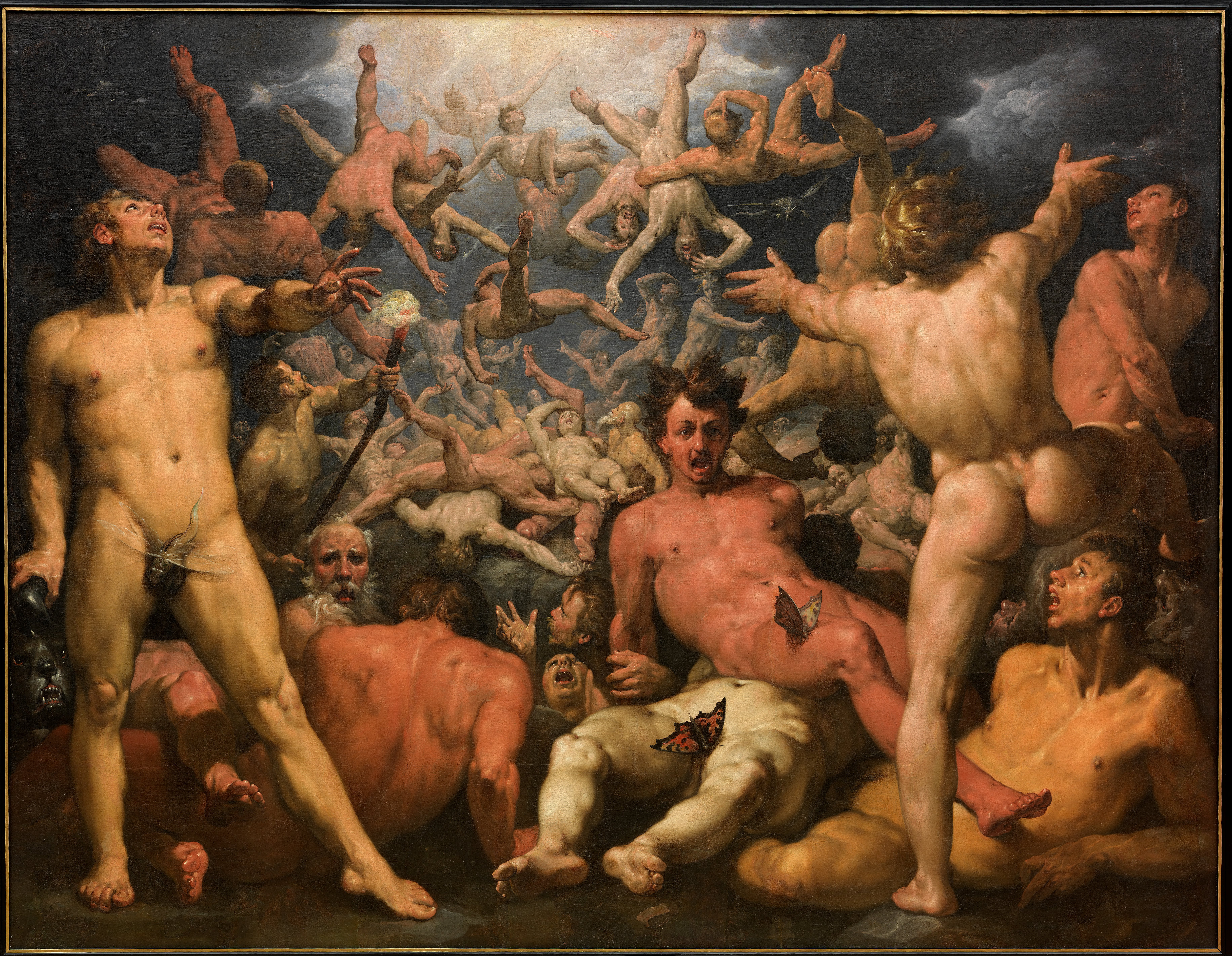|
The St Adrian Civic Guard
''The St Adrian Civic Guard'' is a 1612 militia group portrait painting by the Dutch artist Cornelis Engelsz. It is now in the Musée des Beaux-Arts of Strasbourg, France. Its inventory number is 364.The painting was bought from Charles Sedelmeyer in 1895 by the director of the Strasbourg museum, Wilhelm von Bode, and entered the collections two years later. As of 2014, it was the only Dutch painting of that kind (''schuttersstuk''; English: "militia piece") in a French museum. The painting depicts a banquet of 46 men in arms from the voluntary civic guard of Haarlem. The scene takes place in the civic guard meeting hall, and that is where the painting probably used to hang until the 18th century. One of these faces is supposed to be a self-portrait of Engelsz. Due to its size – ''The St Adrian Civic Guard'' is by far the largest Old Master painting in the Strasbourg collection – the painting could not be evacuated during World War II and was severely damaged when Pa ... [...More Info...] [...Related Items...] OR: [Wikipedia] [Google] [Baidu] |
Cornelis Engelsz
Cornelis Engelsz. (1575–1650) was a Dutch Golden Age painter and the father of Johannes Cornelisz Verspronck. Biography Engelsz was born in Gouda. According to Houbraken, he was a pupil of Karel van Mander and a colleague of Frans Hals in Haarlem. The Frans Hals Museum has several works by him and his son, the portrait painter Johannes Cornelisz Verspronck. According to the RKD he was a pupil of Cornelis Cornelisz and he became a member of the Haarlem Guild of St. Luke in 1593 and was from 1594 to 1621 a member of the schutterij there that he painted in 1618. in the He died in Haarlem. Works [...More Info...] [...Related Items...] OR: [Wikipedia] [Google] [Baidu] |
Old Master
In art history, "Old Master" (or "old master")Old Masters Department Christies.com. refers to any of skill who worked in Europe before about 1800, or a painting by such an artist. An "" is an original print (for example an or |
Militia Group Portraits
A militia () is generally an army or some other fighting organization of non-professional soldiers, citizens of a country, or subjects of a state, who may perform military service during a time of need, as opposed to a professional force of regular, full-time military personnel; or, historically, to members of a warrior-nobility class (e.g. knights or samurai). Generally unable to hold ground against regular forces, militias commonly support regular troops by skirmishing, holding fortifications, or conducting irregular warfare, instead of undertaking offensive campaigns by themselves. Local civilian laws often limit militias to serve only in their home region, and to serve only for a limited time; this further reduces their use in long military campaigns. Beginning in the late 20th century, some militias (in particular officially recognized and sanctioned militias of a government) act as professional forces, while still being "part-time" or "on-call" organizations. For instanc ... [...More Info...] [...Related Items...] OR: [Wikipedia] [Google] [Baidu] |
1612 Paintings
Year 161 ( CLXI) was a common year starting on Wednesday (link will display the full calendar) of the Julian calendar. At the time, it was known as the Year of the Consulship of Caesar and Aurelius (or, less frequently, year 914 ''Ab urbe condita''). The denomination 161 for this year has been used since the early medieval period, when the Anno Domini calendar era became the prevalent method in Europe for naming years. Events By place Roman Empire * March 7 – Emperor Antoninus Pius dies, and is succeeded by Marcus Aurelius, who shares imperial power with Lucius Verus, although Marcus retains the title Pontifex Maximus. * Marcus Aurelius, a Spaniard like Trajan and Hadrian, is a stoical disciple of Epictetus, and an energetic man of action. He pursues the policy of his predecessor and maintains good relations with the Senate. As a legislator, he endeavors to create new principles of morality and humanity, particularly favoring women and slaves. * Aurelius reduc ... [...More Info...] [...Related Items...] OR: [Wikipedia] [Google] [Baidu] |
Paintings In The Collection Of The Musée Des Beaux-Arts De Strasbourg
Painting is the practice of applying paint, pigment, color or other medium to a solid surface (called the "matrix" or "support"). The medium is commonly applied to the base with a brush, but other implements, such as knives, sponges, and airbrushes, can be used. In art, the term ''painting ''describes both the act and the result of the action (the final work is called "a painting"). The support for paintings includes such surfaces as walls, paper, canvas, wood, glass, lacquer, pottery, leaf, copper and concrete, and the painting may incorporate multiple other materials, including sand, clay, paper, plaster, gold leaf, and even whole objects. Painting is an important form in the visual arts, bringing in elements such as drawing, composition, gesture (as in gestural painting), narration (as in narrative art), and abstraction (as in abstract art). Paintings can be naturalistic and representational (as in still life and landscape painting), photographic, abstract, narrative, sy ... [...More Info...] [...Related Items...] OR: [Wikipedia] [Google] [Baidu] |
Frans Hals Museum
The Frans Hals Museum is a museum located in Haarlem, the Netherlands. The museum was established in 1862. In 1950, the museum was split in two locations when the collection of modern art was moved to the '' Museum De Hallen'' (since 2018 called ''Hal)''. The main collection, including its famous 17th-century Frans Hals paintings, for which the museum is named, is located in the former ''Oude Mannenhuis'' on the Groot Heiligland. The museum was founded in 1862 in the newly renovated former Dominican church cloisters located in the back of the Haarlem city hall known as the ''Prinsenhof'', and when it needed more space, it moved to the recently vacated location of the town orphanage in 1913. The collection is based on the large number of paintings owned by the City of Haarlem, which includes over 100 artworks seized from Catholic churches in the 1580s after the Protestant Reformation, and Haarlem art rescued from demolished local buildings from the 15th century onwards. In 2018 t ... [...More Info...] [...Related Items...] OR: [Wikipedia] [Google] [Baidu] |
The Banquet Of The Officers Of The St George Militia Company In 1616
''The Banquet of the Officers of the St George Militia Company in 1616'' refers to the first of several large schutterstukken painted by Frans Hals for the St. George (or St. Joris) civic guard of Haarlem, and today is considered one of the main attractions of the Frans Hals Museum there. Influenced by Cornelis van Haarlem Hals was in his thirties when he painted this piece, and was far from established as a portrait painter. To be safe, he based most of his design on the painting of his predecessor, Cornelis Cornelisz van Haarlem, who painted the same militia company in 1599. Given a nearly impossible task, namely to complete his assignment but to add theatrical elements at the same time, Hals must have spent much time judging the politics of the group. He knew these men well as he served in the St. Joris militia himself from 1612–1615. In his painting, he indicates the political position of each man in the group as well as managing to give each a characteristic portrait. ... [...More Info...] [...Related Items...] OR: [Wikipedia] [Google] [Baidu] |
Frans Hals
Frans Hals the Elder (, , ; – 26 August 1666) was a Dutch Golden Age painter, chiefly of individual and group portraits and of genre works, who lived and worked in Haarlem. Hals played an important role in the evolution of 17th-century group Portrait painting, portraiture. He is known for his loose painterly brushwork. Biography Hals was born in 1582 or 1583 in Antwerp, then in the Spanish Netherlands, as the son of cloth merchant Franchois Fransz Hals van Mechelen ( 1542–1610) and his second wife Adriaentje van Geertenryck.Frans Hals iat the Netherlands Institute for Art History Like many, Hals's parents fled during the Fall of Antwerp (1584–1585) from the south to Haarlem in the new Dutch Republic in the north, where he lived for the remainder of his life. Hals studied under Flemish people, Flemi ... [...More Info...] [...Related Items...] OR: [Wikipedia] [Google] [Baidu] |
Cornelis Van Haarlem
Cornelis Corneliszoon van Haarlem (1562 – 11 November 1638) was a Dutch Golden Age painter and draughtsman, one of the leading Northern Mannerist artists in the Netherlands, and an important forerunner of Frans Hals as a portraitist. Biography Born in Haarlem, Cornelis Corneliszoon was a pupil of Pieter Pietersz in Haarlem, and later Gillis Coignet in Antwerp.Cornelis Cornelisz. van Haarlem in the RKD He is known among art historians as a member of the Haarlem Mannerists, who were highly influenced by the work of |
BNP Paribas
BNP Paribas is a French international banking group, founded in 2000 from the merger between Banque Nationale de Paris (BNP, "National Bank of Paris") and Paribas, formerly known as the Banque de Paris et des Pays-Bas. The full name of the group's parent entity is BNP Paribas S.A. With 190,000 employees as of February 2021, the bank is organized into three major business areas: Commercial, Personal Banking & Services (CPBS), Investment & Protection Services (IPS) and Corporate & Institutional Banking (CIB). The group is listed on the first market of Euronext Paris and a component of the Euro Stoxx 50 stock market index, while it also included in the French CAC 40 index. BNP Paribas is the largest banking group in Europe, after HSBC, and ninth largest Banking group in the world, essentially a bulge bracket. It became one of the five largest banks in the world following the 2008 financial crisis. Despite some legal difficulties in 2014, including being fined the largest ev ... [...More Info...] [...Related Items...] OR: [Wikipedia] [Google] [Baidu] |
Strategic Bombing During World War II
World War II (1939–1945) involved sustained strategic bombing of railways, harbours, cities, workers' and civilian housing, and industrial districts in enemy territory. Strategic bombing as a military strategy is distinct both from close air support of ground forces and from tactical air power. During World War II, many military strategists of air power believed that air forces could win major victories by attacking industrial and political infrastructure, rather than purely military targets. Strategic bombing often involved bombing areas inhabited by civilians, and some campaigns were deliberately designed to target civilian populations in order to terrorize them and disrupt their usual activities. International law at the outset of World War II did not specifically forbid the aerial bombardment of cities – despite the prior occurrence of such bombing during World War I (1914–1918), the Spanish Civil War (1936–1939), and the Second Sino-Japanese War (1937–1945 ... [...More Info...] [...Related Items...] OR: [Wikipedia] [Google] [Baidu] |
Palais Rohan, Strasbourg
The Palais Rohan (Rohan Palace) in Strasbourg is the former residence of the prince-bishops and cardinals of the House of Rohan, an ancient French noble family originally from Brittany. It is a major architectural, historical, and cultural landmark in the city. It was built next to Strasbourg Cathedral in the 1730s, from designs by Robert de Cotte, and is considered a masterpiece of French Baroque architecture. Since its completion in 1742, the palace has hosted a number of French monarchs such as Louis XV, Marie Antoinette, Napoleon and Joséphine, and Charles X. Reflecting the history of Strasbourg and of France, the palace has been owned successively by the nobility, the municipality, the monarchy, the state, the university, and the municipality again. Its architectural conception and its iconography were intended to indicate the return of Roman Catholicism to the city, which had been dominated by Protestantism for the previous two centuries. Thus the prelate's apartments ... [...More Info...] [...Related Items...] OR: [Wikipedia] [Google] [Baidu] |





_-_WGA11053.jpg)



